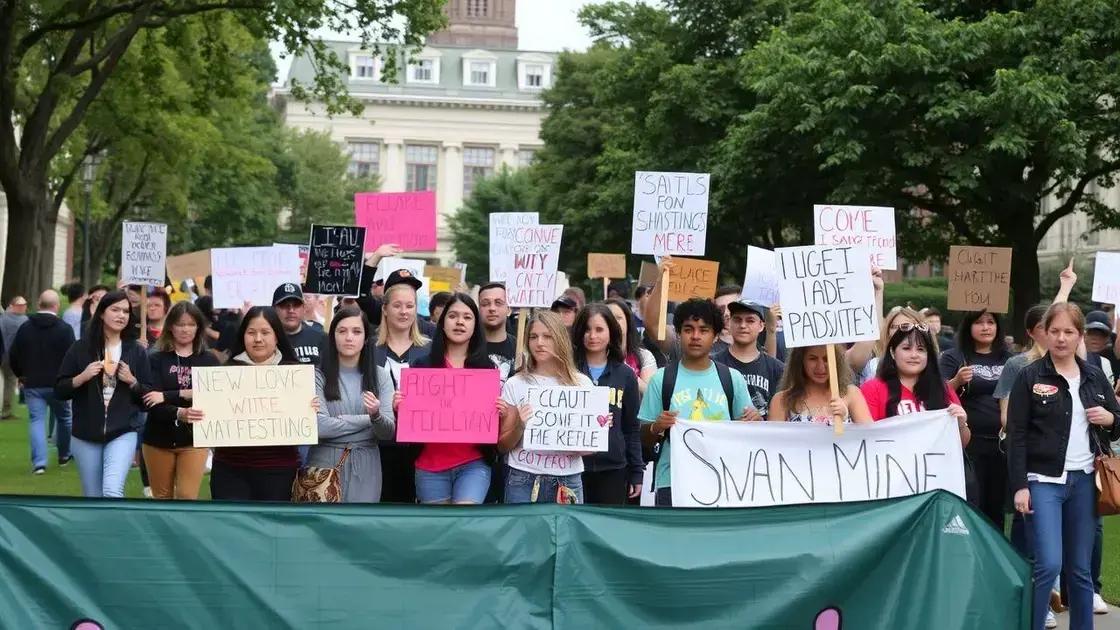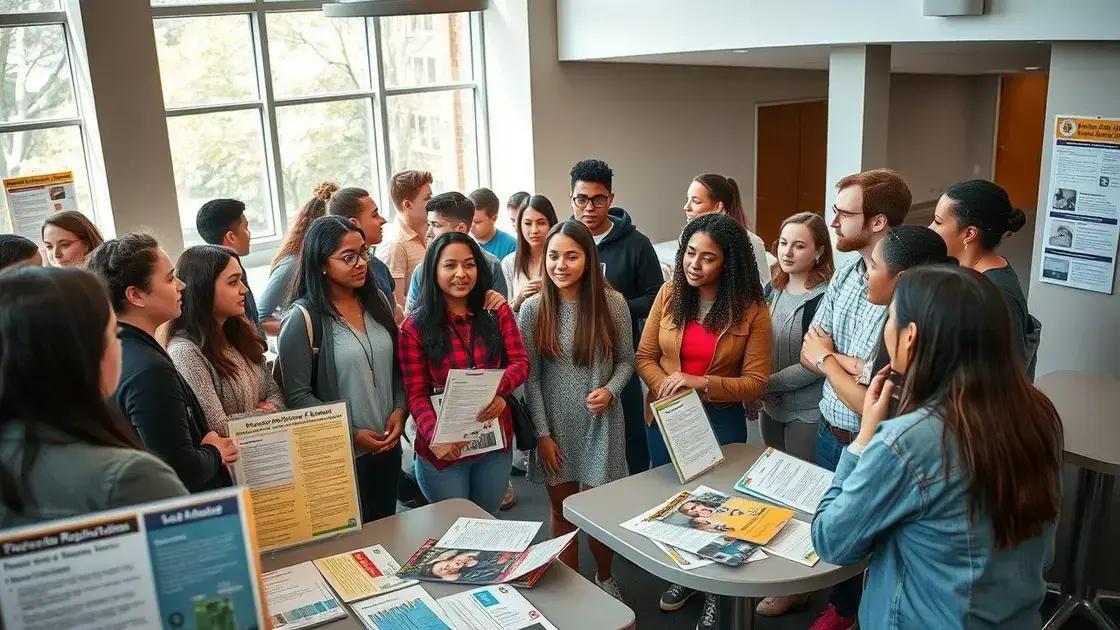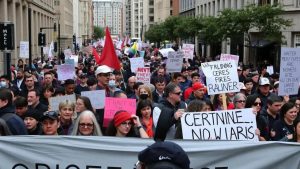Campus protest regulations you need to know

Campus protest regulations specify students’ rights, outline the consequences of violations, and provide guidelines for organizing protests effectively while maintaining safety and order on campus.
Campus protest regulations shape how students express themselves. Knowing these rules can empower you to participate actively while staying within legal boundaries. Curious about what you can and can’t do? Let’s delve into the details.
Understanding campus protest regulations
Understanding campus protest regulations is essential for every student. It helps ensure that your voice is heard while respecting the campus community. Protests are a powerful way to express opinions, but knowing the rules makes it safer and more effective.
The Importance of Regulations
Regulations guide how protests occur on campus. They provide a framework for students to express their views without disrupting the educational environment. Following these rules can also help avoid legal issues or disciplinary actions.
- Promotes peaceful expression of ideas
- Prevents disruption of classes and activities
- Ensures safety for all participants
Key Components of Regulations
Each campus has specific regulations regarding protests. Generally, regulations cover areas such as time, place, and manner of the protest. It’s important to familiarize yourself with these components to avoid conflicts.
For example, some campuses may require students to reserve spaces in advance or may restrict protests during certain hours. Additionally, the use of sound amplification devices might be regulated. Always check with your student affairs office or campus website for the specific rules.
- Reservation of spaces needed
- Timing of protests may be limited
- Sound devices might require permission
Campus protest regulations also emphasize the right to free speech. However, this right is not absolute. Restrictions may apply if the protest poses a risk to safety or property. Understanding these nuances can empower students to plan effective protests.
Moreover, engaging with the administration when organizing protests can lead to a more supportive environment. Communication is key; when staff and students work together, everyone can contribute to a healthy campus dialogue.
Historical context of protests on campuses

The historical context of protests on campuses provides essential insight into how student movements have shaped society. Over the decades, universities have been hotbeds of activism, reflecting the social issues of each era.
Key Historical Movements
Many significant movements have originated on college campuses. The civil rights movement in the 1960s sparked protests advocating for equality and justice. Similarly, the anti-Vietnam War protests mobilized students across the nation. Such events highlight the pivotal role students play in social change.
- 1960s Civil Rights Movement
- Anti-Vietnam War protests
- Anti-apartheid demonstrations in the 1980s
Recent Developments
In recent years, movements such as Black Lives Matter and climate change activism have also taken center stage on campuses. These issues resonate with students today, demonstrating that the spirit of activism remains strong. Currents of social justice and environmental consciousness echo the past while focusing on contemporary concerns.
Students are not only activists but also scholars. They engage in discussions about historical movements and their impact. This engagement fosters a deeper understanding of how previous generations fought for their rights, inspiring today’s activism.
By learning about the past, students can better appreciate the structure of campus protest regulations that emerged in response to these historical events. Regulations often aim to balance free expression with the need for order, reflecting lessons learned from past protests.
Rights students have during protests
Understanding the rights students have during protests is crucial for effective activism on campus. These rights ensure that students can express their views freely while also respecting the rights of others. Knowing your rights helps you navigate the complexities of political expression in a campus setting.
Key Rights During Protests
Students generally have the right to assemble and express their opinions. This includes the ability to gather peacefully, hold signs, and speak out on issues that matter to them. Nonetheless, these rights come with certain responsibilities and limitations.
- Right to assemble peacefully
- Right to free speech and expression
- Right to distribute literature and gather signatures
Limitations and Responsibilities
Although students have many rights, there are restrictions to consider. For instance, protests should not obstruct traffic or disrupt classes. It’s important to follow university guidelines to avoid penalties or misunderstandings.
Additionally, while voicing opinions, it’s essential to maintain respect for differing viewpoints. Disruption of others’ rights can lead to consequences. Awareness of campus protest regulations helps students understand these boundaries better.
Engaging calmly with law enforcement or campus security can also help ensure a successful protest. Being informed about your rights not only empowers you but also fosters an environment where dialogue can occur.
Regulations governing protests and assemblies

The regulations governing protests and assemblies play a vital role in maintaining order on college campuses. These regulations help balance the right to free expression with the need for safety and respect for others. Understanding these rules can empower students to organize effectively while minimizing potential issues.
Types of Regulations
Each campus may have its own set of guidelines, but common regulations include the following:
- Time restrictions that may limit when protests can occur
- Designated areas for protests to prevent disruption
- Requirements for obtaining permits, especially for larger gatherings
Why Regulations Matter
Regulations exist to ensure that protests are conducted peacefully and do not interfere with the rights of other students. By following these guidelines, organizers can enhance the likelihood of a successful event. Awareness of campus regulations can help students avoid issues with law enforcement or campus security.
Additionally, regulations may include safety protocols, such as having a clear plan for emergencies. It’s essential for students to communicate their plans to university authorities to ensure everyone’s safety during a protest.
When regulations are followed, protests can inspire change and foster dialogue within the campus community. Engaging with university officials can further enhance the understanding and impact of student movements.
Strategies for organizing a peaceful protest
Organizing a peaceful protest requires careful planning and clear communication. Effective strategies can help ensure that your message is heard while maintaining a safe and respectful environment. By using these strategies, students can mobilize effectively and reduce the potential for conflict.
Set Clear Goals
Before organizing a protest, it’s important to determine what you want to achieve. Setting clear goals can guide how you plan and execute the event. Identify key issues and articulate your message to gain support.
- Define the purpose of your protest
- Gather relevant facts and data to support your cause
- Engage other students and groups who share your goals
Choose the Right Location and Time
Selecting an appropriate location and time for your protest is crucial. Choose a spot that will attract attention but also allows for safe gathering. Consider the timing of classes and events to maximize participation without disrupting the campus.
Communicating with university authorities about your plans can help ensure safety. They can assist in providing necessary permits or managing logistics, which can prevent disruptions.
Promoting your protest effectively through social media, flyers, and word of mouth can increase attendance, too. Engage your peers and create excitement around the event.
Maintain Peaceful Conduct
During the protest, it is essential to maintain a peaceful demeanor. Remind participants of the importance of respectful communication. Setting ground rules for conduct can help keep the focus on the message rather than on conflict.
Providing training for participants on de-escalation techniques can also be beneficial. This helps prepare students for handling conflicts, ensuring everyone remains committed to peaceful expression.
Consequences of violating protest regulations

Understanding the consequences of violating protest regulations is crucial for students who wish to engage in activism on campus. These regulations are put in place to ensure safety and order during protests. Ignoring them can lead to serious repercussions for individuals and organizations involved.
Types of Consequences
When protest regulations are broken, various consequences can follow. These may include disciplinary actions from the university or even legal consequences. It’s essential for students to be aware of possible outcomes before participating in a protest.
- Possible suspension or expulsion from the university
- Fines or legal charges for unlawful assembly
- Damage to the student organization’s reputation
Impact on Activism
Violating regulations can also deter others from participating in activism. When protests turn chaotic or confrontational, potential supporters may feel unsafe or hesitant to join. This can diminish the overall impact of the protest and the message intended.
Furthermore, negative consequences can undermine the legitimacy of the cause. Authorities and the public may focus on the violation instead of the issues at hand. Maintaining a peaceful and lawful protest is vital to garnering public and institutional support.
Students should seek to understand campus protest regulations fully to navigate their rights responsibly. By adhering to guidelines, they can effectively rally for their causes while minimizing risks.
FAQ – Frequently Asked Questions about Campus Protest Regulations
What are the main rights students have during protests?
Students have the right to assemble peacefully, express their opinions, and distribute literature on campus, as long as they follow university regulations.
What are some common regulations for organizing a protest?
Common regulations include time and location restrictions, requirements for permits, and guidelines for peaceful conduct to ensure safety.
What can happen if regulations are violated?
Violating protest regulations can lead to disciplinary actions such as suspension, fines, or even legal consequences, which may impact the student’s reputation.
How can students organize a peaceful protest effectively?
Effective organization includes setting clear goals, choosing the right time and location, maintaining peaceful conduct, and ensuring all participants understand their rights.






